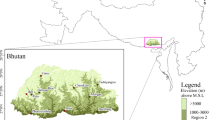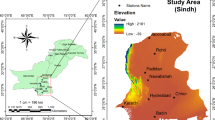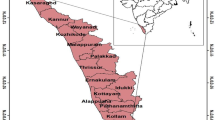Abstract
The occurrence and severity of extreme precipitation events have been increasing globally. Although numerous projections have been proposed and developed for evaluating the climate change impacts, most models suffer from significant bias error due to the coarse resolution of the climate datasets, which affects the accuracy of the climate change assessment. Therefore, in this study, post-processing techniques (interpolation and bias correction methods) were adopted on the database for Policy Decision Making for Future Climate Change (d4PDF) model for extreme climatic flood events simulation in the Chao Phraya River Basin, Thailand, under + 4-K future climate simulation. Due to the limited number of the rain gages, the gradient plus inverse distance squared interpolation method (combination of multiple linear regression and distance weighting methods) was applied in this study. In the bias correction methods, the additional setting of monthly and seasonal periods was adjusted. The proposed bias correction approach deployed gamma distribution combined with generalized Pareto distribution setting with the seasonal period for the rainy season datasets, whereas only the gamma setting was applied with the monthly period during the dry season. The outcomes revealed that the proposed method could react to extreme rainfall events, expand dry days during dry season, and intensify rainfall amount during rainy season. The post-processing d4PDF trends of six sea surface temperature (SST) patterns (consists of 90 ensemble members) of two periods (near future: 2051–2070 and far future: 2091–2110) recorded the highest and lowest amounts of annual rainfalls of 4,450 mm/year in mid-stream of Nan River and 710 mm/year in the lower CPRB, respectively. Notably, the significant variances noted in the rainfall patterns among ensembles, demanding further investigation in future climate change, impact studies. The findings of the study provided novel insights on the importance of proper post-processing techniques for improving the robustness of d4PDF in climate change impacts assessment.















Similar content being viewed by others
Data availability
The raw data that support the findings of this study are obtained from the Pollution Control Department, Thailand. Restrictions apply to the availability of these data, which were used under permission for this study. Data are available from the authors upon reasonable request and with the permission of Pollution Control Department, Thailand.
References
Budhathoki A, Tanaka T, Tachikawa Y (2022) Correcting streamflow bias considering its spatial structure for impact assessment of climate change on floods using d4PDF in the Chao Phraya River Basin, Thailand. J Hydrol: Region Stud 42:101150
Coles SG (2001) An introduction to statistical modeling of extreme values. Springer Ser Stat. https://doi.org/10.1007/978-1-4471-3675-0
Collins M, Knutti R, Arblaster J, Dufresne J-L, Fichefet T, Friedlingstein P, Gao X, Gutowski WJ, Johns T,Krinner G, Shongwe M, Tebaldi C, Weaver AJ, Wehner M (2013) Long-term climate change: projections, commitments and irreversibility. In: Stocker TF, Qin D, Plattner G-K, Tignor M, Allen SK, Boschung J, Nauels A, Xia Y, Bex V, Midgley PM (eds) Climate Change 2013: The Physical Science Basis. Contribution of Working GroupI to the Fifth Assessment Report of the Intergovernmental Panel on Climate Change. Cambridge UniversityPress, Cambridge, United Kingdom and New York, NY, USA. https://www.ipcc.ch/site/assets/uploads/2018/02/WG1AR5_Chapter12_FINAL.pdf
Deser C, Phillips A, Bourdette V et al (2012) Uncertainty in climate change projections: the role of internal variability. Clim Dyn 38:527–546. https://doi.org/10.1007/s00382-010-0977-x
Ehret U, Zehe E, Wulfmeyer V, Warrach-Sagi K, Liebert J (2012) HESS opinions “should we apply bias correction to global and regional climate model data?” Hydrol Earth Syst Sci 16(9):3391–3404. https://doi.org/10.5194/hess-16-3391-2012
Evans JP, Ekström M, Ji F (2012) Evaluating the performance of a WRF physics ensemble over South-East Australia. Clim Dyn 39(6):1241–1258. https://doi.org/10.1007/s00382-011-1244-5
Gudmundsson L, Bremnes JB, Haugen JE, Engen-Skaugen T (2012) Technical note: Downscaling RCM precipitation to the station scale using statistical transformations - a comparison of methods. Hydrol Earth Syst Sci 16(9):3383–3390. https://doi.org/10.5194/hess-16-3383-2012
Gumindoga W, Rientjes THM, Haile AT, Makurira H, Reggiani P (2016) Bias correction schemes for CMORPH satellite rainfall estimates in the Zambezi River Basin. Hydrol Earth Syst Sci Discussions 1–36. https://doi.org/10.5194/hess-2016-33
Gutjahr O, Heinemann G (2013) Comparing precipitation bias correction methods for high-resolution regional climate simulations using COSMO-CLM: effects on extreme values and climate change signal. Theor Appl Climatol 114(3–4):511–529. https://doi.org/10.1007/s00704-013-0834-z
Hanittinan P, Tachikawa Y, Ichikawa Y, Yorozu K (2017) Change of the probability distribution of annual maximum river discharge derived from the d4PDF datasets at the Indochinese Peninsula. THAI 2017 International Conference Water Management Climate Change Asia’s Water-Energy-Food Nexus
Hofstra N, Haylock M, New M, Jones P, Frei C (2008) Comparison of six methods for the interpolation of daily, European climate data. J Geophys Res Atmos 113(21). https://doi.org/10.1029/2008JD010100
Katz RW (1999) Extreme value theory for precipitation: sensitivity analysis for climate change. Adv Water Resour 23(2):133–139. https://doi.org/10.1016/S0309-1708(99)00017-2
Knutti R, Sedláček J, Sanderson BM, Lorenz R, Fischer EM, Eyring V (2017) A climate model projection weighting scheme accounting for performance and interdependence. Geophys Res Lett 44:1909–1918. https://doi.org/10.1002/2016GL072012
Kure S, Tebakari T (2012) Hydrological impact of regional climate change in the Chao Phraya River Basin, Thailand. Hydrol Res Lett 6:53–58. https://doi.org/10.3178/HRL.6.53
Ligaray M, Kim H, Sthiannopkao S, Lee S, Cho KH, Kim JH (2015) Assessment on hydrologic response by climate change in the Chao Phraya River basin, Thailand. Water 7:6892–6909. https://doi.org/10.3390/w7126665
Meehl GA, Tebaldi C, Adams-Smith D (2016) US daily temperature records past, present, and future. Proc Natl Acad Sci U S A 113:13977–13982
Mendez M, Maathuis B, Hein-Griggs D, Alvarado-Gamboa LF (2020) Performance evaluation of bias correction methods for climate change monthly precipitation projections over Costa Rica. Water (Switzerland) 12(2). https://doi.org/10.3390/w12020482
Mizuta R, Murata A, Ishii M, Shiogama H, Hibino K, Mori N et al (2017) Over 5,000 years of ensemble future climate simulations by 60-km global and 20-km regional atmospheric models. Bull Am Meteorol Soc 98(7):1383–1398
Nalder I, Wein RW (1998) Spatial interpolation of climatic normals: test of a new method in the Canadian boreal forest. Agric for Meteorol 92:211–225. https://doi.org/10.1016/S0168-1923(98)00102-6
Ogata T, Saavedravaleriano OC, Yoshimura C, Liengcharernsit W, Hirabayashi Y (2012) Past and future hydrological simulations of Chao Phraya river basin. Annu J Hydraul Eng 56:97–102
Piani C, Haerter JO, Coppola E (2010) Statistical bias correction for daily precipitation in regional climate models over Europe. Theor Appl Climatol 99(1–2):187–192. https://doi.org/10.1007/s00704-009-0134-9
Promchote P, Wang SYS, Johnson PG (2016) The 2011 great flood in Thailand: climate diagnostics and implications from climate change. J Clim 29(1):367–379. https://doi.org/10.1175/JCLI-D-15-0310.1
Sakaa B, Elbeltagi A, Boudibi S et al (2022) Water quality index modeling using random forest and improved SMO algorithm for support vector machine in Saf-Saf river basin. Environ Sci Pollut Res 29:48491–48508. https://doi.org/10.1007/s11356-022-18644-x
Stahl K, Moore RD, Floyer JA, Asplin MG, McKendry IG (2006) Comparison of approaches for spatial interpolation of daily air temperature in a large region with complex topography and highly variable station density. Agric for Meteorol 139(3–4):224–236. https://doi.org/10.1016/j.agrformet.2006.07.004
Supharatid S (2015) Skill of precipitation projection in the Chao Phraya River Basin by multi-model ensemble CMIP3-CMIP5. Weather Clim Extremes 12:1–14. https://doi.org/10.1016/j.wace.2016.03.001
Try S, Tanaka S, Tanaka K, Sayama T, Hu M, Sok T, Oeurng C (2020) Projection of extreme flood inundation in the Mekong River basin under 4K increasing scenario using large ensemble climate data. Hydrol Process 34(22):4350–4364. https://doi.org/10.1002/hyp.13859
Try S, Tanaka S, Tanaka K, Sayama T, Khujanazarov T, Oeurng C (2022) Comparison of CMIP5 and CMIP6 GCM performance for flood projections in the Mekong River Basin. J Hydrol: Region Stud 40:101035
Usman M, Ndehedehe CE, Farah H, Ahmad B, Wong Y, Adeyeri OE (2022) Application of a conceptual hydrological model for streamflow prediction using multi-source precipitation products in a semi-arid river basin. Water 14(8):1260. https://doi.org/10.3390/w14081260
Valdés-Pineda R, Demaría EMC, Valdés JB, Wi S, Serrat-Capdevilla A (2016) Bias correction of daily satellite-based rainfall estimates for hydrologic forecasting in the Upper Zambezi, Africa. Hydrol Earth Syst Sci Discussions 1–28. https://doi.org/10.5194/hess-2016-473
Wilks DS (2006) Statistical methods in atmospheric sciences, 2nd ed. San Diego, Academic Press
Wong YJ, Shimizu Y, He K et al (2020) Comparison among different ASEAN water quality indices for the assessment of the spatial variation of surface water quality in the Selangor river basin, Malaysia. Environ Monit Assess 192:644. https://doi.org/10.1007/s10661-020-08543-4
Wong YJ, Shimizu Y, Kamiya A et al (2021) Application of artificial intelligence methods for monsoonal river classification in Selangor river basin, Malaysia. Environ Monit Assess 193:438. https://doi.org/10.1007/s10661-021-09202-y
Wu F, Li W, Zhang P, Li W (2021) Relative contributions of internal atmospheric variability and surface processes to the interannual variations in wintertime arctic surface air temperatures. J Climate 34:7131–7148. https://doi.org/10.1175/JCLI-D-20-0779.1
Yang W, Johan A, Graham LP, Olsson J (2010) Distribution-based scaling to improve usability of regional climate model projections for hydrological climate change impacts studies. Hydrol Res 41:211–230
Yang X, Xie X, Liu DL, Ji F, Wang L (2015). Spatial interpolation of daily rainfall data for local climate impact assessment over Greater Sydney region. Adv Meteorol 2015. https://doi.org/10.1155/2015/563629
Acknowledgements
The observed data were provided by the Thai Meteorological Department. We would like to extend our gratitude to Mr. David Stenzel for his kind comments and valuable advice. Co-author Luksanaree Maneechot thanks her scholarship donor, Japan Ministry of Education, Culture, Sports, Science and Technology (Monbukagakusho: MEXT) for funding this research as a part of her PhD work. The authors would like to express their gratitude to the Kyoto University of Advanced Science for the technical and financial support in this study.
Author information
Authors and Affiliations
Contributions
Luksanaree Maneechot: conceptualization, methodology, formal analysis, data curation, software, and writing—original draft preparation. Yong Jie Wong: methodology, formal analysis, data curation, software, and writing—original draft preparation. Sophal Try: formal analysis, methodology, software, and writing—original draft preparation. Yoshihisa Shimizu: supervision, funding acquisition, and writing—review and editing. Khagendra Pralhad Bharambe: formal analysis, methodology, and writing—review and editing. Patinya Hanittinan: methodology and writing—original draft preparation. Teerawat Ram-Indra: methodology and writing—original draft preparation. Muhammad Usman: data curation, software, and writing—review and editing.
Corresponding author
Ethics declarations
Ethics approval and consent to participate
Not applicable.
Consent for publication
Not applicable.
Competing interests
The authors declare no competing interests.
Additional information
Responsible Editor: Marcus Schulz
Publisher's Note
Springer Nature remains neutral with regard to jurisdictional claims in published maps and institutional affiliations.
Rights and permissions
Springer Nature or its licensor (e.g. a society or other partner) holds exclusive rights to this article under a publishing agreement with the author(s) or other rightsholder(s); author self-archiving of the accepted manuscript version of this article is solely governed by the terms of such publishing agreement and applicable law.
About this article
Cite this article
Maneechot, L., Wong, Y.J., Try, S. et al. Evaluating the necessity of post-processing techniques on d4PDF data for extreme climate assessment. Environ Sci Pollut Res 30, 102531–102546 (2023). https://doi.org/10.1007/s11356-023-29572-9
Received:
Accepted:
Published:
Issue Date:
DOI: https://doi.org/10.1007/s11356-023-29572-9




